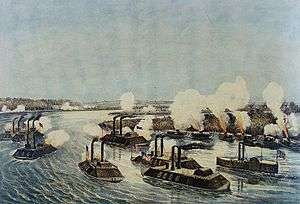Mississippi River Squadron
The Mississippi River Squadron was the Union brown-water naval squadron that operated on the western rivers during the American Civil War. It was initially created as a part of the Union Army, although it was commanded by naval officers, and was then known as the Western Gunboat Flotilla and sometimes as the Mississippi Flotilla. It received its final designation when it was transferred to the Union Navy at the beginning of October 1862.
| Mississippi River Squadron | |
|---|---|
 Vessels of the Mississippi River Squadron in the Battle of Island Number Ten. | |
| Active | 1861 - 1865 |
| Country | |
| Branch | |
| Type | Naval squadron |
| Engagements | American Civil War |
History
American Civil War
The squadron was created on May 16, 1861, and was controlled by the Union Army until September 30, 1862. John Rodgers was the first commander of the squadron and was responsible for the construction and organization of the fleet. Flag Officer Andrew H. Foote relieved Rodgers and encouraged the army commander in the west, Major General Henry W. Halleck, to authorize an expedition down the Tennessee River against Fort Henry. Operating in conjunction with Ulysses S. Grant's Army of the District of Cairo, Foote subdued Fort Henry before Grant's troops could take their positions.
.jpg)
Foote led the squadron in the attack on Fort Donelson and then joined with Maj. Gen. John Pope's Army of the Mississippi for a joint attack on Island No. 10 on the Mississippi River. Charles H. Davis relieved Foote and proceeded to take Fort Pillow on the Mississippi. The U. S. Ram Fleet, commanded by Colonel Charles Ellet, Jr., accompanied the squadron during the Battle of Memphis. After the capture of Memphis the squadron was transferred to the control of the U.S. Navy. The transfer included the Ram Fleet, by then reconstituted as the Mississippi Marine Brigade. Davis aided Grant's unsuccessful first campaign against Vicksburg. Rear Admiral David D. Porter relieved Davis in command and led the squadron at Arkansas Post and during the successful Vicksburg Campaign and siege of the city.
Red River Campaign
Porter led the squadron during the disastrous Red River Campaign of 1864, and when the waters of the river dropped, the fleet was almost lost. The engineering abilities of Colonel Joseph Bailey, who supervised the construction of Bailey's Dam, helped save the fleet. During the Red River Campaign, the Mississippi Squadron was composed of 10 ironclads, 3 monitors, 11 tin-clads, 1 timber-clad, 1 ram and various support vessels, including vessels in the following table:
| Ship | Type |
|---|---|
| USS Osage | twin-turret river monitor |
| USS Neosho | twin-turret river monitor |
| USS Ozark | single-turret river monitor |
| USS Eastport | casemate ironclad |
| USS Essex | casemate ironclad |
| USS Baron DeKalb | casemate ironclad |
| USS Benton | casemate ironclad |
| USS Carondelet | casemate ironclad |
| USS Cincinnati | casemate ironclad |
| USS Louisville | casemate ironclad |
| USS Mound City | casemate ironclad |
| USS Pittsburgh | casemate ironclad |
| USS Lexington | timberclad |
| USS Moose | sternwheel steamer |
| USS Ouachita | sidewheeler steamer |
| USS Nyanza | sidewheeler steamer |
Command temporarily passed to Alexander Pennock before Samuel P. Lee assumed command. Lee was in command until the squadron was discontinued on August 14, 1865.
List of Commanding Officers
| Squadron Commander | From | To | Major Battles |
|---|---|---|---|
| Commander John Rodgers | 16 May 1861 | 30 August 1861 | construction of squadron |
| Flag Officer Andrew H. Foote | 30 August 1861 | 9 May 1862 | Fort Henry, Fort Donelson, Island No. 10 |
| Flag Officer Charles H. Davis | 9 May 1862 | 15 October 1862 | Fort Pillow, Memphis, Chickasaw Bayou |
| Rear Admiral David D. Porter | 15 October 1862 | July 1864 | Arkansas Post, Vicksburg, Red River Campaign |
| Captain Alexander M. Pennock | July 1864 | 1 November 1864 | temporary |
| Rear Admiral Samuel P. Lee | 1 November 1864 | 14 August 1865 |
See also
References
- Eicher, John H. and Eicher, David J. (2001) Civil War High Commands, Stanford University Press, ISBN 0-8047-3641-3
- Mahan, A. T. (1885). The Navy in the Civil War. New York, Charles Scribner's sons.
- Nevin, David (1983) The Road to Shiloh: Early Battles in the West, The Civil War series, Alexandria, VA : Time-Life Books, ISBN 0-8094-4716-9